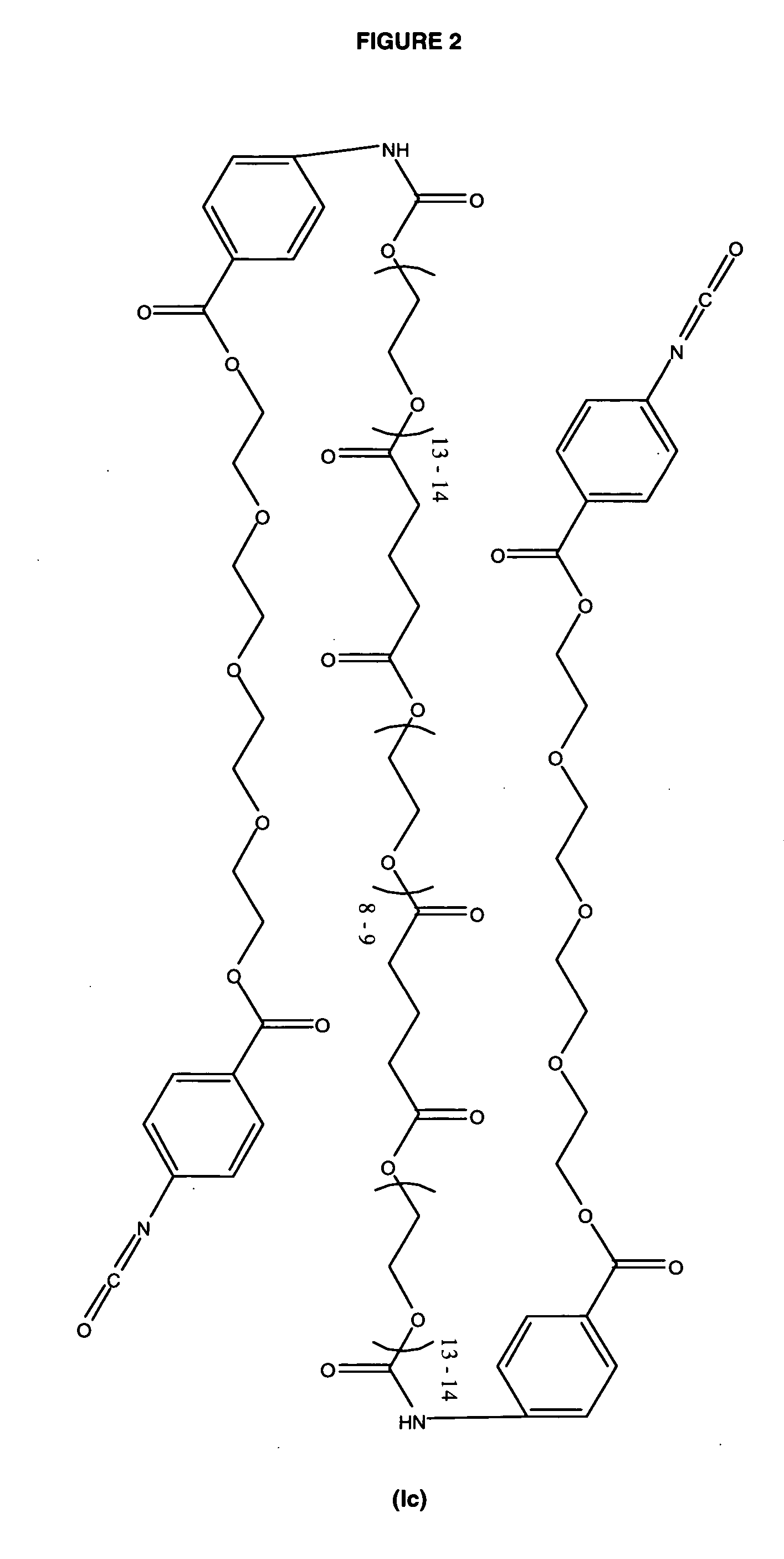Method of making a diisocyanate terminated macromer
a technology of diisocyanate and macromer, which is applied in the field of new polyisocyanate macromer, can solve the problems of unsuitable human use as internal adhesive or sealant, unsuitable small molecule diisocyanate monomers, and undesirable accumulation of water insoluble fragments in the body
- Summary
- Abstract
- Description
- Claims
- Application Information
AI Technical Summary
Benefits of technology
Problems solved by technology
Method used
Image
Examples
example 1
Preparation of Polymers
Prepolymer B1
[0086] A 10% solution of ethyl acetate was prepared with 1 mol of tetraethylene glycol, 2.75 mol of 4-nitro benzoyl chloride, and 6 equivalents of sodium carbonate. This reaction was carried out with magnetic stirring under nitrogen at room temperature and atmospheric pressure. The di-nitro intermediate:
was next hydrogenated. To the ethyl acetate solution containing the dinitro intermediate palladium catalyst (10% Pd on carbon) was added at 5% w / w with vigorous stirring and a hydrogen sparge. This resulted in the di-amine intermediate:
[0087] The diamine was purified by washing with aqueous sodium bicarbonate and brine, followed by drying over anhydrous magnesium sulfate. This diamine powder was then dried at 50° C. under vacuum for 12 hours. The purity of the diamine was 99.1% by HPLC.
[0088] To prepare the diisocyanate the following procedure was used. In a one liter, three neck flask 68.62 g (0.231 mol) triphosgene and 375 mL of ethylene...
example 2
Preparation of Polymers
Polyester Polyol for Macromer Id
[0094] To a clean, dry 250 mL 3 neck flask fitted with nitrogen inlet, temperature probe and dean-stark trap was charged 8.72 g (0.0947 moles) of Glycerin USP. The contents were heated to 120° C. with stirring under nitrogen. Upon reaching temperature, vacuum was applied for 2 hours. Vacuum was released and 32.46 g (0.2845 moles) of Glutaric Anhydride was added. The solution was stirred under nitrogen at 120° C. for 2 hours until IR showed no anhydride present. The solution was cooled and 167.09 g (0.2784 moles) of PEG 600 NF and 0.20 g (0.0009 moles) of Tin (II) Oxalate were added. The flask was heated to 180° C. and held for 2 hours under nitrogen sparge. Vacuum was applied for an additional 17 hours after which the conversion of acid to ester groups was 99.98% based on the acid content. The polyol was cooled to 80° C. and the following were added; 6.13 g of silica-citric acid and 2.38 g of diatomaceous earth. The slurry wa...
example 3
Preparation of Polymers
Polyester Polyol for Macromer Ic
[0096] To a clean, dry 1L 4-neck flask fitted with mechanical stirrer, nitrogen inlet, temperature probe and dean-stark trap was charged 149.79 g (0.3744 moles) of PEG 400 NF. The contents were heated to 120° C. with stirring under nitrogen. Upon reaching temperature, vacuum was applied for 1.5 hours. Vacuum was released and 85.56 g (0.7499 moles) of Glutaric Anhydride was added. The solution was stirred under nitrogen at 120° C. for 2.5 hours until IR showed no anhydride present. The solution was cooled and 436.06 g (0.7268 moles) of PEG 600 NF and 0.67 g (0.0032 moles) of Tin (II) Oxalate were added. The flask was heated to 180° C. and held for 2 hours under nitrogen sparge. Vacuum was applied for an additional 16 hours after which the conversion of acid to ester groups was 99.96% based on the acid content. The polyol was cooled to 80° C. and the following were added; 6.97 g of silica-citric acid, 7.11 g of diatomaceous ear...
PUM
| Property | Measurement | Unit |
|---|---|---|
| temperatures | aaaaa | aaaaa |
| w/w | aaaaa | aaaaa |
| temperatures | aaaaa | aaaaa |
Abstract
Description
Claims
Application Information
 Login to View More
Login to View More - R&D
- Intellectual Property
- Life Sciences
- Materials
- Tech Scout
- Unparalleled Data Quality
- Higher Quality Content
- 60% Fewer Hallucinations
Browse by: Latest US Patents, China's latest patents, Technical Efficacy Thesaurus, Application Domain, Technology Topic, Popular Technical Reports.
© 2025 PatSnap. All rights reserved.Legal|Privacy policy|Modern Slavery Act Transparency Statement|Sitemap|About US| Contact US: help@patsnap.com



